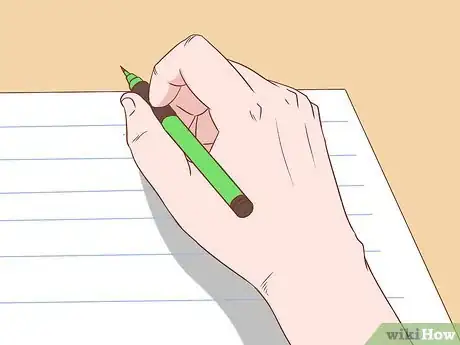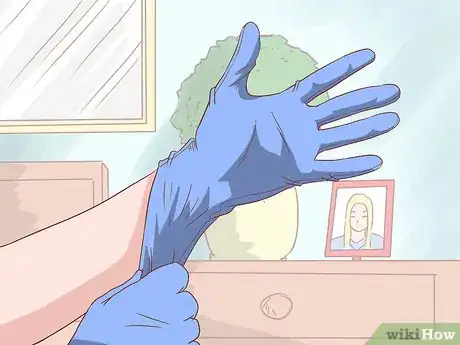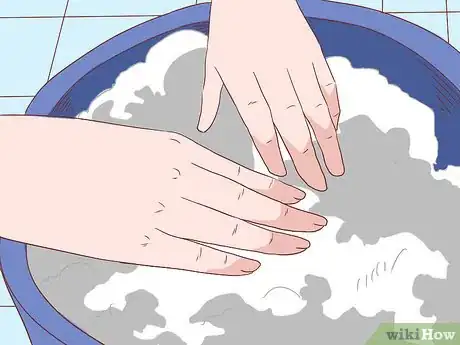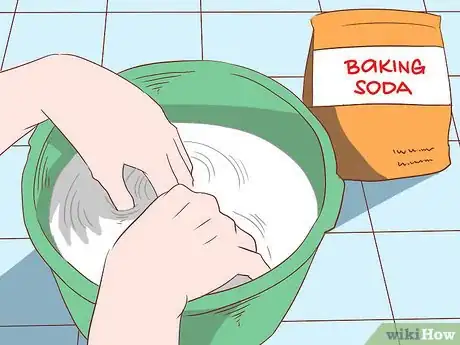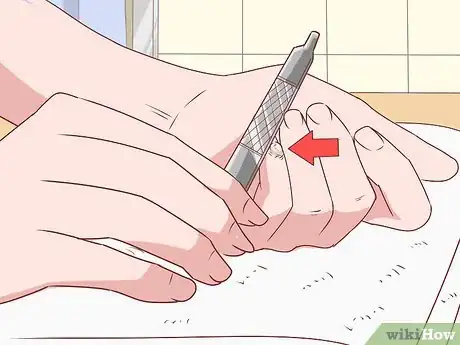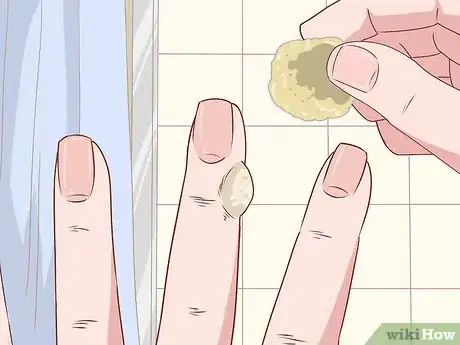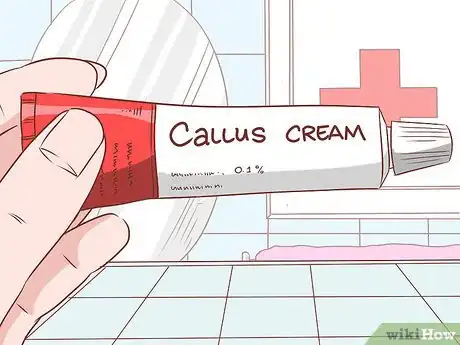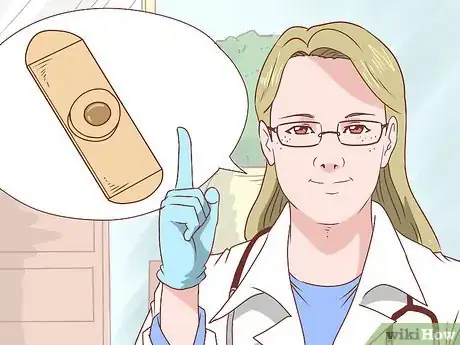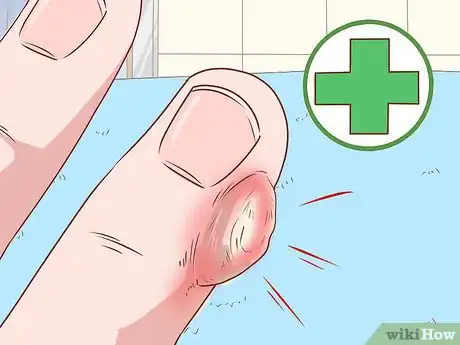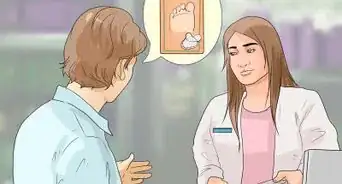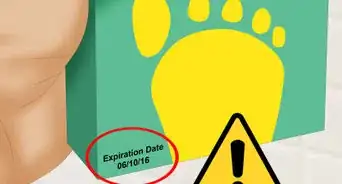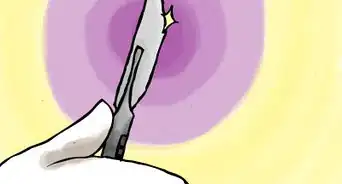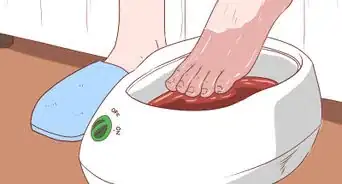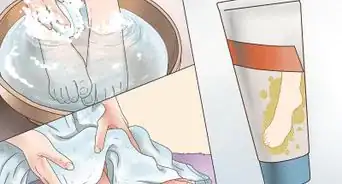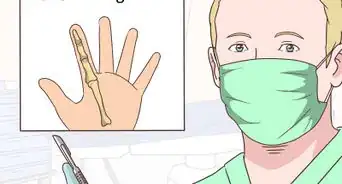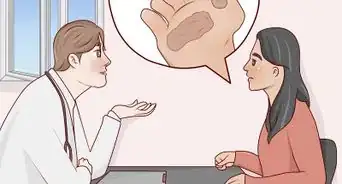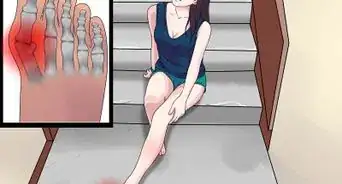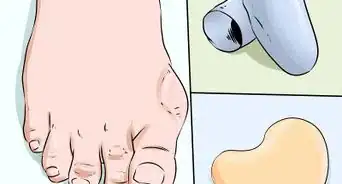This article was co-authored by Chris M. Matsko, MD. Dr. Chris M. Matsko is a retired physician based in Pittsburgh, Pennsylvania. With over 25 years of medical research experience, Dr. Matsko was awarded the Pittsburgh Cornell University Leadership Award for Excellence. He holds a BS in Nutritional Science from Cornell University and an MD from the Temple University School of Medicine in 2007. Dr. Matsko earned a Research Writing Certification from the American Medical Writers Association (AMWA) in 2016 and a Medical Writing & Editing Certification from the University of Chicago in 2017.
wikiHow marks an article as reader-approved once it receives enough positive feedback. This article received 12 testimonials and 83% of readers who voted found it helpful, earning it our reader-approved status.
This article has been viewed 765,924 times.
A writer's callus, or writer's bump, is a thick lump of dead skin that forms on the fingers to protect the sensitive skin underneath from the pressure and friction of the pen or pencil rubbing against the skin. They are generally not painful or dangerous. They are just your body's way of protecting itself. There are several simple, painless ways to remove them.[1]
Steps
Caring For Your Writer's Callus At Home
-
1Reduce the amount of stress you put on your fingers when you write. Because calluses are your body's defense mechanism for preventing irritation to sensitive skin, you may be able to get rid of your callus by simply reducing the friction when you write.
-
2Provide extra protection for your hand by wearing a soft glove or using moleskin as padding. This will cushion the skin and prevent the pen or pencil from rubbing directly on your skin.
- If it is too warm to comfortably wear a thin glove, protect just the area with the callus by wearing a Band-Aid or moleskin over the callus when you write.
- You can create a donut-shaped pad by folding the moleskin in half and cutting a half circle out of it. Then apply the moleskin donut around the callus. This will reduce the pressure on the callus.[2]
- Or alternatively, you can put the moleskin on the pen or pencil to make it softer.
Advertisement -
3Take a bath and soak your hand in the warm soapy water to help soften the thick protective layer of dead skin.
- Keep your hand submerged until the skin around the callus becomes wrinkled and then gently massage the callus.
-
4Use natural remedies to soak your hand. These methods will help soften and exfoliate the callus. You can try them all until you find the one that works the best for you. Soak for at least 10 minutes to get the best results.
- Soak your callus in warm water with Epsom salt dissolved into it. Follow the directions on the box to adjust the concentration of salt to water.[3]
- Create a solution of warm water and baking soda. Baking soda is a natural exfoliant.
- Or alternatively, soak your hand in warm chamomile tea. Chamomile has anti-inflammatory properties which will soothe irritation from the pen or pencil rubbing.
- You can also try a warm mixture of castor oil and apple cider vinegar. The oil will have a moisturizing effect and the acid in the vinegar will help soften the skin and promote healing.
-
5Rub the dead skin away with a nail file, emery board, pumice stone, or washcloth. This should not cause pain because the skin is already dead. Do not grind down so deeply that you hit sensitive, live skin underneath. You may need to do this repeatedly over several days.
- Do not use a pumice stone if you have diabetes because it increases your risk of infection.
- Do not cut or clip the callus away as this increases your chances of going too deep and injuring yourself.[4]
-
6Apply moisturizers to soften the callus. Gently massage the moisturizer into the callus and surrounding skin. You can use commercially manufactured moisturizers or various home-remedies including:
- Vitamin E oil
- Coconut oil
- Olive Oil
- Aloe. Aloe can be applied using either a commercially prepared mixture, or if you have a plant in your house, you can split open a leaf and apply the soothing, gooey gel directly onto the callus.
-
7Use naturally acidic household substances to soften the callus and loosen the dead skin. These substances can be held in place against the callus with a bandage. Leave them on for at least a few hours or even overnight to give them time to work. Some things you can try include:
- Lemon juice, soaked into a cotton ball
- Vinegar, soaked into a cotton ball
- A slice of raw onion, soaked in lemon juice and salt or vinegar
Applying Medications and Seeking Medical Care
-
1Try over-the-counter medications for removing calluses. Patches containing salicylic acid are available which you can put on the callus.[5]
- Follow the manufacturer's instructions and your doctor's recommendations for how often to change the patch.[6] These medications must be applied carefully, because if they come in contact with the healthy, live skin around the callus, they may cause chemical burns.[7]
- Do not use these methods if you have diabetes, poor circulation, or are prone to numbness. In this case, consult your doctor.[8]
-
2Apply aspirin as an alternative source of salicylic acid. By crushing up aspirin tablets, you can make your own topical medicine and apply it.[9]
- Grind five aspirin tablets into a powder and add a half teaspoon lemon juice and a half teaspoon water. Mix until a paste forms.
- Apply the paste to the callus, not to the healthy, live skin surrounding it.
- Wrap it in plastic wrap and put a warm towel on it for 10 minutes. Afterwards scrub away the paste and any loose dead skin.
-
3
-
4Contact a medical professional if your callus shows signs of being infected. Calluses generally are not associated with infection, so if yours shows any of these symptoms, it should be examined by a doctor:[11]
- Redness
- Pain
- Inflammation
- Discharging blood or pus
Expert Q&A
Did you know you can get premium answers for this article?
Unlock premium answers by supporting wikiHow
-
QuestionIs there any surgery for it?
 Chris M. Matsko, MDDr. Chris M. Matsko is a retired physician based in Pittsburgh, Pennsylvania. With over 25 years of medical research experience, Dr. Matsko was awarded the Pittsburgh Cornell University Leadership Award for Excellence. He holds a BS in Nutritional Science from Cornell University and an MD from the Temple University School of Medicine in 2007. Dr. Matsko earned a Research Writing Certification from the American Medical Writers Association (AMWA) in 2016 and a Medical Writing & Editing Certification from the University of Chicago in 2017.
Chris M. Matsko, MDDr. Chris M. Matsko is a retired physician based in Pittsburgh, Pennsylvania. With over 25 years of medical research experience, Dr. Matsko was awarded the Pittsburgh Cornell University Leadership Award for Excellence. He holds a BS in Nutritional Science from Cornell University and an MD from the Temple University School of Medicine in 2007. Dr. Matsko earned a Research Writing Certification from the American Medical Writers Association (AMWA) in 2016 and a Medical Writing & Editing Certification from the University of Chicago in 2017.
Family Medicine Physician
-
QuestionIs a callus from using a drywall screw gun the same as a writer's callus?
 Chris M. Matsko, MDDr. Chris M. Matsko is a retired physician based in Pittsburgh, Pennsylvania. With over 25 years of medical research experience, Dr. Matsko was awarded the Pittsburgh Cornell University Leadership Award for Excellence. He holds a BS in Nutritional Science from Cornell University and an MD from the Temple University School of Medicine in 2007. Dr. Matsko earned a Research Writing Certification from the American Medical Writers Association (AMWA) in 2016 and a Medical Writing & Editing Certification from the University of Chicago in 2017.
Chris M. Matsko, MDDr. Chris M. Matsko is a retired physician based in Pittsburgh, Pennsylvania. With over 25 years of medical research experience, Dr. Matsko was awarded the Pittsburgh Cornell University Leadership Award for Excellence. He holds a BS in Nutritional Science from Cornell University and an MD from the Temple University School of Medicine in 2007. Dr. Matsko earned a Research Writing Certification from the American Medical Writers Association (AMWA) in 2016 and a Medical Writing & Editing Certification from the University of Chicago in 2017.
Family Medicine Physician
Warnings
- If you have diabetes or another condition that causes poor blood circulation, consult your doctor before beginning any home treatment.⧼thumbs_response⧽
References
- ↑ http://www.mayoclinic.org/diseases-conditions/corns-and-calluses/basics/definition/con-20014462
- ↑ http://www.besthealthmag.ca/best-you/home-remedies/natural-home-remedies-calluses-and-corns#G6xTdgppBqt8BLkf.97
- ↑ http://www.besthealthmag.ca/best-you/home-remedies/natural-home-remedies-calluses-and-corns#G6xTdgppBqt8BLkf.97
- ↑ http://www.mayoclinic.org/diseases-conditions/corns-and-calluses/basics/treatment/con-20014462
- ↑ http://www.mayoclinic.org/diseases-conditions/corns-and-calluses/basics/treatment/con-20014462
- ↑ http://www.mayoclinic.org/diseases-conditions/corns-and-calluses/basics/treatment/con-20014462
- ↑ http://www.webmd.com/skin-problems-and-treatments/understanding-corns-calluses-treatment
- ↑ http://www.webmd.com/skin-problems-and-treatments/understanding-corns-calluses-treatment
- ↑ http://www.besthealthmag.ca/best-you/home-remedies/natural-home-remedies-calluses-and-corns#G6xTdgppBqt8BLkf.97
About This Article
To get rid of a writer's callus, start by soaking your callus in warm water mixed with baking soda or Epsom salts, which will help soften it so it's easier to remove. Then, exfoliate the callus using a nail file, pumice stone, or washcloth until you've rubbed off all of the dead skin. If home remedies aren't helping, pick up some over-the-counter salicylic acid patches from the store and apply one to your callus. For tips on what to do if you think your callus is infected, scroll down!
